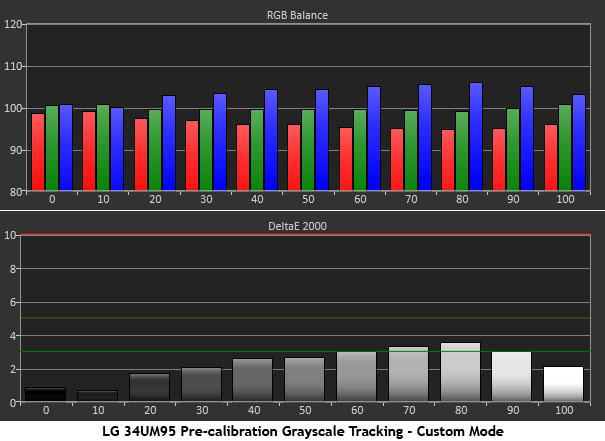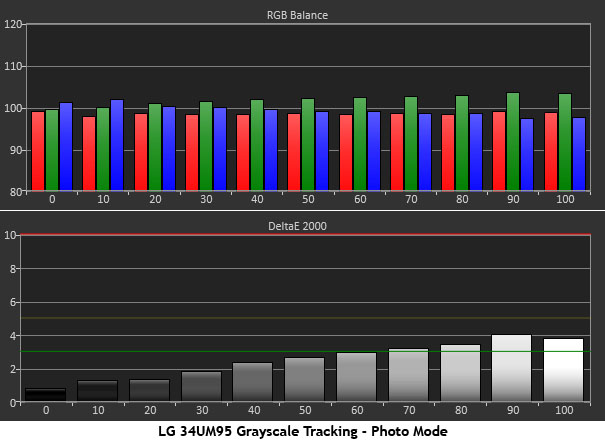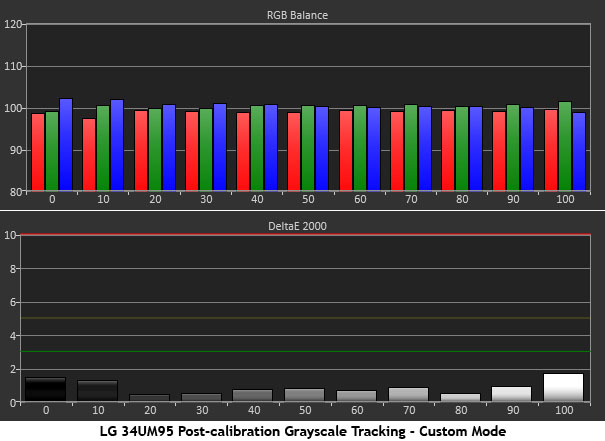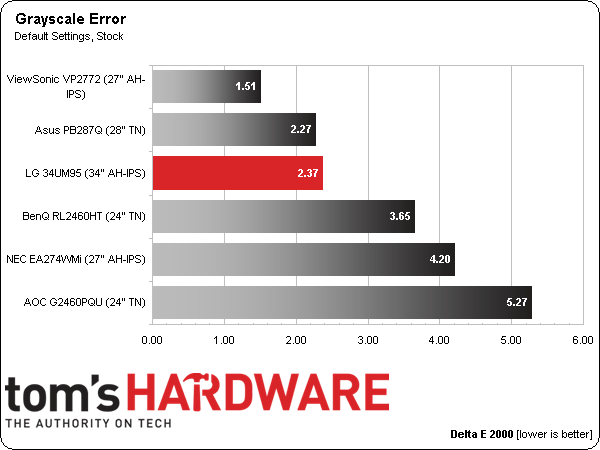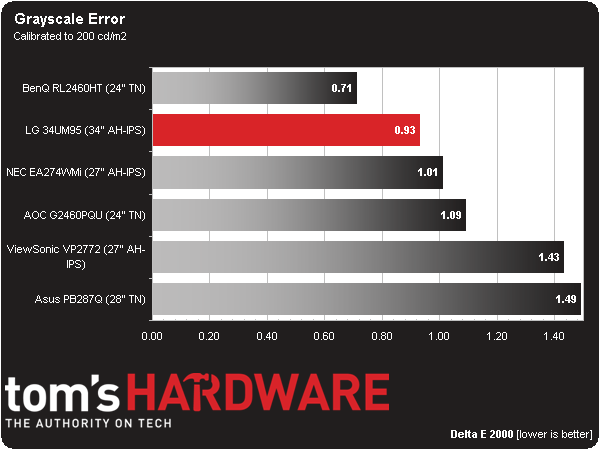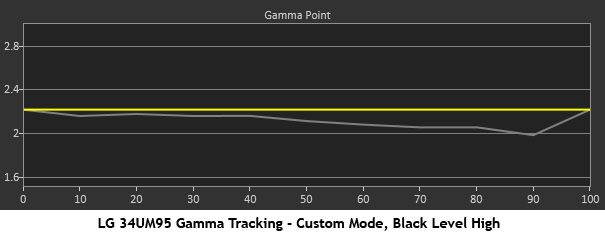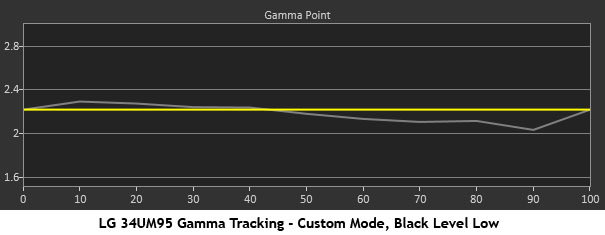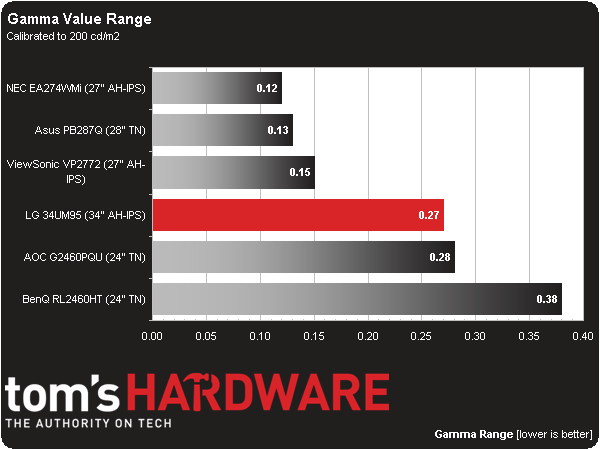LG 34UM95 34-Inch Ultra-Wide QHD Monitor Review
When we looked at 29-inch ultra-wide displays last year, we asked for greater size and more pixels. LG answers that request with its 34UM95, a 34-inch panel with a resolution of 3440x1440. Today we run it through our performance and usability analysis.
Results: Grayscale Tracking And Gamma Response
The majority of monitors, especially newer models, display excellent grayscale tracking (even at stock settings). It’s important that the color of white be consistently neutral at all light levels from darkest to brightest. Grayscale performance impacts color accuracy with regard to the secondary colors: cyan, magenta, and yellow. Since the 34UM95’s CMS can’t correct all color gamut errors, accurate grayscale is key.
LG's 34UM95 is set to its Custom picture mode by default. The resulting un-calibrated grayscale is just a tad cool. The error is barely visible and only at the 70- and 80-percent levels. Out-of-box performance is definitely above average.
If you don’t plan to calibrate, we recommend using the Photo mode instead.
As you've seen, the Photo mode offers a little more light output and its grayscale accuracy is about the same as Custom. You still have access to Brightness, but the Contrast and Color controls are locked out. The errors are visible at the 70- to 100-percent levels, showing just a hint of green. We still consider this above-average performance.
Here is our calibrated result:
Calibrating the Custom mode yields the best grayscale accuracy. You give up around 20 percent of the available contrast, so some users might opt to leave the RGB sliders and/or the Contrast control alone and simply adjust Brightness to taste. Either way, we expect you’ll be satisfied.
Here is our comparison group:
Get Tom's Hardware's best news and in-depth reviews, straight to your inbox.
An average error of 2.37 Delta E is comfortably below the visibility point. Most brightness levels have no visible error at all. The ones that do will take sharp eyes to detect.
Calibration puts the 34UM95 on par with many professional displays.
It’s hard to find a monitor much more accurate than this. We think the compromise in contrast is worth such an excellent result. Since we were unable to try out the automatic calibration, we can’t say whether it's possible to get even better numbers. Visually, however, you wouldn’t be able to tell the difference.
Gamma Response
Gamma is the measurement of luminance levels at every step in the brightness range from 0 to 100 percent. It's important because poor gamma can either crush detail at various points or wash it out, making the entire picture appear flat and dull. Correct gamma produces a more three-dimensional image, with a greater sense of depth and realism. Meanwhile, incorrect gamma can negatively affect image quality, even in monitors with high contrast ratios.
In the gamma charts below, the yellow line represents 2.2, which is the most widely used standard for television, film, and computer graphics production. The closer the white measurement trace comes to 2.2, the better.
LG's 34UM95 has three gamma presets, but all of the charts we’re showing represent the Gamma 1 option. Our intent is to illustrate the difference between the Custom and Photo modes, along with the impact of Black Level.
You can’t change the gamma in Photo mode, so you’re stuck with tracking shown above. Luminance errors become brighter as you move towards 100-percent brightness. In actual content, the image lacks a little depth compared to one with a flatter gamma trace.
In Custom mode, you have a choice of High or Low for the Black Level control.
The differences are subtle. However, set to High, the trace stays below 2.2 throughout the entire brightness range. At 90 percent, the error maxes out at 4.1 cd/m2, which is barely visible.
We think image quality is superior at the Low setting.
I realize it's only a small change, but I can really tell the difference looking at actual content. The error starts a little too dark and slides under the line at the 40-percent mark. Now the maximum error is 3 cd/m2.
Here is our comparison group again:
The average of our tested monitors is about .27. LG's 34UM95 doesn't demonstrate the flattest tracking we’ve seen, but it’s pretty close to our standard.
We calculate gamma deviation by simply expressing the difference from 2.2 as a percentage.
The 34UM95’s deviation result is a good deal better than average. Gamma 1 with the Black Level set to Low definitely produces the best numbers in our gamma tests.
Current page: Results: Grayscale Tracking And Gamma Response
Prev Page Results: Brightness And Contrast Next Page Results: Color Gamut And Performance
Christian Eberle is a Contributing Editor for Tom's Hardware US. He's a veteran reviewer of A/V equipment, specializing in monitors. Christian began his obsession with tech when he built his first PC in 1991, a 286 running DOS 3.0 at a blazing 12MHz. In 2006, he undertook training from the Imaging Science Foundation in video calibration and testing and thus started a passion for precise imaging that persists to this day. He is also a professional musician with a degree from the New England Conservatory as a classical bassoonist which he used to good effect as a performer with the West Point Army Band from 1987 to 2013. He enjoys watching movies and listening to high-end audio in his custom-built home theater and can be seen riding trails near his home on a race-ready ICE VTX recumbent trike. Christian enjoys the endless summer in Florida where he lives with his wife and Chihuahua and plays with orchestras around the state.
-
rantoc 4k gaming is amazing but demand alot from the computer hardware. Just got a dell 3214 and its hard to describe how much better the picture/emersion is with the way higher definition in the picture quality and still came from descent 2560x1600 before that.Reply
Playing on "full" hd (LD? Low definition) feels like a joke once you get to know uhd/4k -
wtfxxxgp Rantoc, what does your comment have to do with the article? Seems to me that you were waiting for an opportunity to brag about your new monitor... Glad you got that out of your system. lolReply
With regards to this monitor...I LOVE the looks...very elegant. I think the price tag is fitting as well - it has great resolution and there are still plenty of people who are gaming on 60hz displays that may have just enough GPU power to actually game at this thing's native resolution, albeit with slightly lower settings. GG LG! -
xPandaPanda I have this monitor. Because of it's cinema format, market age, lower production numbers, and early adoption as competitors haven't offered this yet, it is reasonable to think this monitor would cost this much--a lot.Reply
It would have been nice to include what revision this is, because LG is aware of uniformity issues, which is why the product was largely on backorder and a Rev.2 is in place (but Rev. 2 didn't fix the problem either). My first one had a glaring Uniformity problem, but LG is cool and offered an advanced exchange. The new one has some uniformity problem, but it is very 'livable' and discrete.
Overall, I am pleased with this product. I have a single 780 to push this and it works nicely. If I got a 4k monitor, I'd have performance issues as the GPU as a whole sector is behind.
-
eklipz330 as a pc gamer who has been playing for ~15 years, i have to say that this is one of the biggest changes that i've seen on the pc platform. this is a big step towards bringing pc back to relevancy. it's something that will be held to acclaim in productive and gaming environments. in fact, the only thing that i'm surprised that they didn't do is make it curved, simply because when a user sets up a multi-monitor setup, they set the outside monitors at an angle. this makes curved monitor solutions make sense more so than tvs, especially since curved monitors benefit solo users the most. im shocked they didnt make it curved. probably going to cash in next year on that.Reply
seriously though, pc monitors have been lacking for some years now, falling behind in innovation and technology in general(phones have been jacking up their screen quality year after year, we've been stuck since like 2005). i bet 21:9 screens will have the biggest penetration on PCs. -
josejones Why still the old HDMI 1.4 instead of HDMI 2.0 and DisplayPort 1.2 instead of the new 1.4 ???Reply
